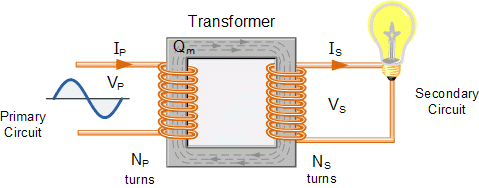
- A transformer is a device that converts high voltage AC to low voltage AC of the same frequency and vice versa.
- It works on the principle of mutual induction, i.e. whenever the current (magnetic flux) through a coil changes, an EMF is induced in the neighboring coil.
- A transformer is widely used in electric and electronic devices, such as radio, TV, trolley bus, computers and factories.
What is mutual induction?
- Mutual induction is the property of the coil that enables it to oppose the change in the current in another coil.
- According to this principle, when the electric current in a closed circuit (primary coil) changes, the changing current (AC) creates a changing magnetic field.
- A secondary circuit (secondary coil) in reach of this magnetic field will experience this change in magnetic field as a change in its related magnetic flux.
- Therefore, an electromotive force (EMF) or voltage change is set up in the secondary circuit (secondary coil) called induced EMF or Transformer EMF. This effect is called mutual induction.
- If the two ends of the secondary coil are connected through an electrical load, current will flow.
Structure of a transformer:
- A transformer consists of two separate coils (primary and secondary coils) winding on a laminated iron core.
- The coil of the transformer in which AC voltage is given (input) is called a primary coil and the coil from which AC voltage is taken (output) is called secondary coil.
- The iron core, when used in a single block develops eddy current, and the core is heated up.
- The heat thus produced damages the internal insulation besides causing loss of energy.
- In order to minimize the heating effect, thin insulated metal sheets are adjusted to make the core of a transformer. These iron sheets are coated with insulating material like varnish and shellac. This process is called lamination.
- Hence, the core of the transformer is laminated to minimize energy loss due to production of eddy current.
Primary voltage and secondary voltage:
- The input voltage of a transformer is called primary voltage (V1) and the output voltage is called a secondary voltage (V2).
- The number of turns in the secondary coil (n2) can be calculated by the following relation.
V2/V1 = n2/n1
where,
V2=secondary voltage
V1= primary voltage
n2= number of turns in secondary coil
n1= number of turns in primary coil
- With the appropriate selection of the number of turns, a transformer thus allows an alternating voltage to be stepped up or stepped down.
A transformer is based on the following two laws:
- In a transformer, the input power (I1V1) is equal to the output power (I2V2), where I1= input current, V1= input voltage, I2=output current and V2= output voltage.
- The magnitude of the induced EMF is directly proportional to the ratio of the number of turns in the secondary coil to the number of turns in the primary coil.
Types of transformers:
• There are two types of transformers;
- Step up transformer
- Step down transformer
1. Step up transformer:
• The transformer which converts low voltage AC to high voltage AC is called step up transformer.
• Such transformer consists of more number of turns in the secondary coil than in the primary coil, i.e. n2 > n1.
• It is used in electric grids to save electrical energy during power transmission through overhead wires.
• It is also used in television sets, refrigerators etc. and for producing X-rays in X-ray tubes.
2. Step down transformer:
• The transformer which converts high voltage AC to low voltage AC is called step down transformer.
• Such transformer consists of less number of turns in secondary coil than in the primary coil, i.e. n2 < n1.
• It is used at power sub-stations to step down the voltage before its distribution to consumers.
• It is also used in radios, cassette players, TV sets etc.

